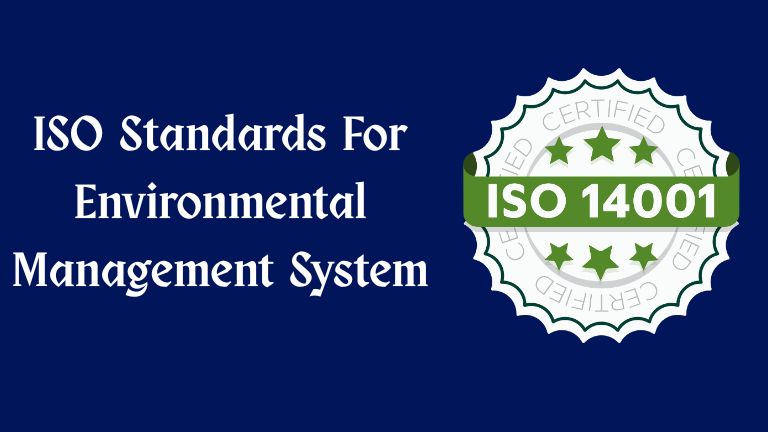In today’s world, being environmentally sustainable isn’t just the right thing to do; it’s essential for business success. With climate change, resource depletion, and pollution taking center stage in global conversations, companies are under increasing pressure to handle their environmental impact responsibly. That’s where ISO standards for environmental management systems come into play, offering a solid framework to help businesses reduce their ecological footprint while still operating efficiently.
What is an Environmental Management System (EMS)?
An Environmental Management System (EMS) is a systematic approach that organizations use to keep track of, manage, and enhance their environmental performance. It includes policies, procedures, practices, and records that outline how a company interacts with the environment.
The ISO standards for environmental management systems, especially ISO 14001, provide guidance for organizations looking to establish an effective EMS. These standards are recognized worldwide and can be applied to any organization, no matter its size, industry, or location.
Understanding ISO 14001: The Core Standard
Of all the ISO standards for environmental management systems, ISO 14001 is the most widely embraced. It lays out the requirements for creating, implementing, maintaining, and continuously improving an EMS. The key principles of ISO 14001 include:
-
Environmental Policy: This defines the organization’s commitment to compliance, pollution prevention, and ongoing improvement.
-
Planning: This involves identifying environmental aspects, legal obligations, and setting objectives and targets.
-
Implementation and Operation: This focuses on building capabilities, communication strategies, and operational control measures.
-
Checking and Corrective Action: This includes monitoring performance, auditing the EMS, and taking corrective actions when necessary.
-
Management Review: This is about assessing the system’s effectiveness and making any needed adjustments.
By adhering to ISO standards for environmental management systems, businesses can take a proactive approach to tackle environmental issues in a structured and measurable manner.
Benefits of Implementing ISO Standards for Environmental Management System
Embracing ISO 14001 and related ISO standards for environmental management brings a host of strategic advantages:
1. Regulatory Compliance
Companies that follow ISO standards often find it simpler to meet local and international environmental regulations. These standards assist in pinpointing relevant legal obligations and weaving them into everyday operations.
2. Reduced Environmental Impact
With a well-organized Environmental Management System (EMS) in place, businesses can significantly cut down on waste, emissions, and resource use, making a positive contribution to the environment.
3. Enhanced Reputation
Showing a commitment to sustainability through ISO certification can elevate a company’s standing among customers, investors, and regulatory bodies.
4. Cost Savings
Boosting resource efficiency, managing waste better, and optimizing energy use can lead to considerable cost savings over time.
5. Market Advantage
Achieving ISO 14001 certification can provide businesses with a competitive edge, especially when competing for environmentally sensitive projects or government contracts.
Integration with Other Management Systems
The ISO standards for environmental management systems are crafted to work seamlessly with other ISO standards, like ISO 9001 (Quality Management) and ISO 45001 (Occupational Health and Safety). This compatibility enables organizations to develop an Integrated Management System (IMS), which streamlines operations and minimizes redundancies.
For instance, a company might combine its quality, safety, and environmental policies into one cohesive framework, simplifying staff training, compliance monitoring, and overall improvement efforts.
Other ISO Standards Supporting Environmental Management
While ISO 14001 is the cornerstone, several other standards complement the ISO standards for environmental management system. These include:
-
ISO 14004: Offers general guidelines on principles, systems, and support techniques.
-
ISO 14031: Focuses on environmental performance evaluation.
-
ISO 14044: Pertains to life cycle assessment (LCA), helping businesses evaluate the environmental impact of products and processes throughout their life span.
-
ISO 14046: Addresses water footprint assessment.
-
ISO 50001: Though not strictly part of the ISO 14000 family, it focuses on energy management and aligns well with environmental objectives.
Together, these standards form a holistic toolkit for organizations aiming to embrace environmental responsibility at every level.
Steps to Get ISO 14001 Certified
Implementing the ISO standards for environmental management system and achieving ISO 14001 certification involves several steps:
-
Gap Analysis: Evaluate current practices against ISO 14001 requirements.
-
Planning: Develop a project plan to establish an EMS.
-
Training: Educate employees and assign roles and responsibilities.
-
Documentation: Create required documents, including policies, procedures, and records.
-
Implementation: Execute the EMS across all departments and locations.
-
Internal Audit: Review and refine the EMS through internal audits.
-
Management Review: Senior management assesses the EMS performance.
-
Certification Audit: Conducted by a third-party certification body.
-
Continual Improvement: Make ongoing enhancements to ensure sustained compliance and performance.
Challenges and How to Overcome Them
While embracing ISO standards for environmental management systems can bring significant benefits, it does come with its own set of challenges. Here are a few to consider:
-
Lack of Internal Expertise: Bringing in specialists or providing training can help bridge this gap.
-
Resistance to Change: Open communication and strong leadership can foster acceptance and ease the transition.
-
Cost of Certification: Although there’s an initial expense, the long-term savings and benefits often make it worth the investment.
Conclusion
As the global push for environmental responsibility continues to grow, businesses that adopt ISO standards for environmental management systems not only safeguard their future but also play a part in creating a more sustainable world. Whether you’re a small business or a large corporation, implementing an EMS based on ISO 14001 can be a game-changer for both operational excellence and environmental responsibility.
By embedding these standards into your organization’s core practices, you send a clear message: your business is not just about profits—it's also about protecting the world we all share.

